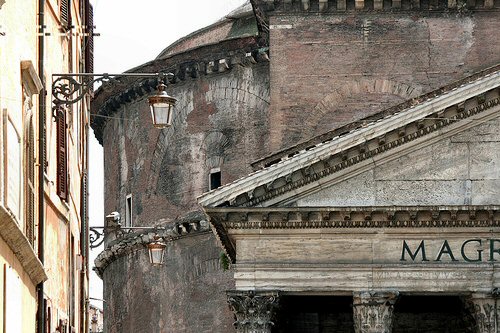|
La Chambre Des Reines
|
Architecture
|
The Pantheon in Rome - Italy
"In Rome, the Pantheon, so great
within and without,

(click on picture to see more of the Pantheon) The Pantheon in Rome, Italy, is one of the most fascinating buildings I've ever seen. It stands as the most complete Roman structure on earth, having survived 20 centuries of plunder, pillage and invasion. It is the best preserved of all Roman buildings and perhaps the best preserved building of its age in the world. Before the current Pantheon, from Greek Πάνθεον (pan=all, theon=the gods, meaning: "Temple of all the Gods"* ) was built, two other buildings occupied the same site.The first one, a traditional rectilinear, T-shaped structure was built in 27 BC by the emperor Marcus Agrippa, son-in-law of the emperor Augustus, to commemorate the victory of Actium over Antony and Cleopatra. The temple was dedicated to the gods Mars and Venus. It burned in AD 80 but was rebuilt by emperor Domitian. In AD 110 the building was struck by lightning and burned again. In AD 118 emperor Hadrian**, a cosmopolitan emperor who had traveled widely in the East, commissioned for the Pantheon to be rebuilt but with a totally different design. This time the Pantheon building would last much longer. Hadrian himself is credited with the basic plan, an architectural design that was unique for the time. (click on picture to see more of the Pantheon) The Pantheon was maintained and restored by the emperors Septimus Severus (193-211) and Caracalla (211-17). During its two centuries as a functioning temple, statues of gods filled the niches. Animals were sacrificed and burned in the center; the smoke escaped through the only means of light, the oculus. (See next page) After Christianity replaced paganism in Rome, the Pantheon was abandoned for a time. Public pagan worship was prohibited in 346 and most pagan temples were closed. Fortunately, a decree of 408 ordered that temples were to be put to new use; thus some have been preserved and were used as secular buildings. The Pantheon remained unused until the Byzantine emperor Phocas gave it to Pope Boniface IV (608-15), thus unwittingly ensuring that one of the marvels of ancient Rome would be preserved, virtually unaltered, in its new guise as the Christian church: "Santa Maria ad Martyres" in 609 AD. (See next page under: panoramic view of the interior of the Pantheon) It was the first pagan temple in Rome to be Christianized, although the practice had been common in the East since the 4th century. The church was dedicated to the Virgin Mary and all the martyrs, thus continuing the tradition of a "catch-all" place of worship. As part of the consecration in 609, an altar was placed in the main apse opposite the entrance, with an icon of the Virgin and Child placed above it. (click on picture to see more of the Pantheon) In later centuries the Pantheon was subsequently robbed and restored again several times. In the 16th century, Michelangelo came to the Pantheon to study its dome before he began work on the dome of St. Peter's (whose dome is 2 feet smaller) Even in its altered state where much of its outer decoration has been stripped over the millennia and its incredible interior modified, the Pantheon still exemplifies the Roman aim for perfection in structural integrity and philosophical harmony.
A legend of construction Hadrian was a particularly benevolent emperor, adored by the citizens of Rome. To build the dome, the interior of the Pantheonís circular brick and concrete drum was filled with a mound of earth. A fortune of golden coins was mixed into the earthen tumulus. After the dome was poured on top of this solid formwork, and had cured, the doors of the Pantheon opened for the first time, and citizens of Rome were invited to carry the earth away and keep the coins that they found.
* The generic term pantheon is now applied to a monument in which illustrious dead are buried. ** The design of the extant building is sometimes credited to the Trajan's architect Apollodorus of Damascus, but it is equally likely that the building and the design should be credited to the Emperor Hadrian or his architects. Hadrian undeniably is one of history's extraordinary figures, due to his actions as Emperor. He is probably most famous for "The Hadrian Wall", a stone and turf fortification, built in 122 - 30 AD, across the width of what is now northern England. Built to prevent military raids on Roman Britain by Pictish tribes, who were the ancient inhabitants of Scotland.
|

